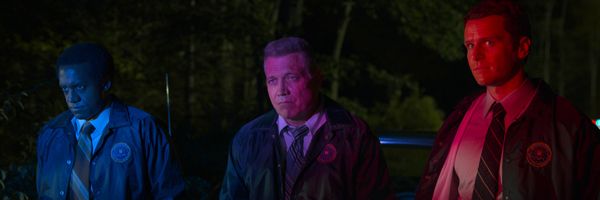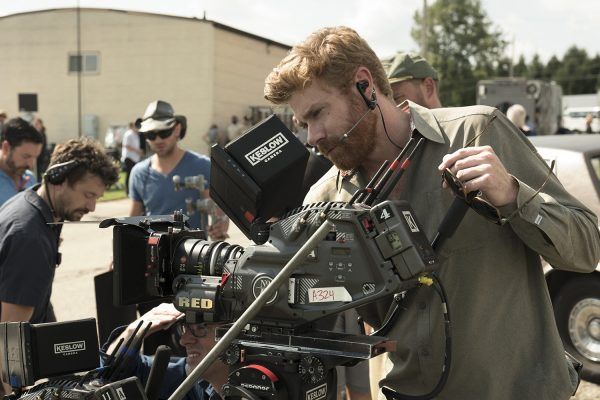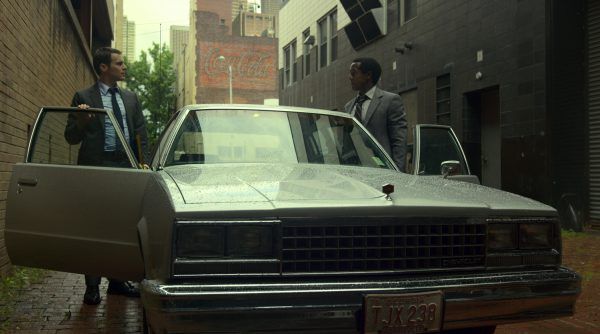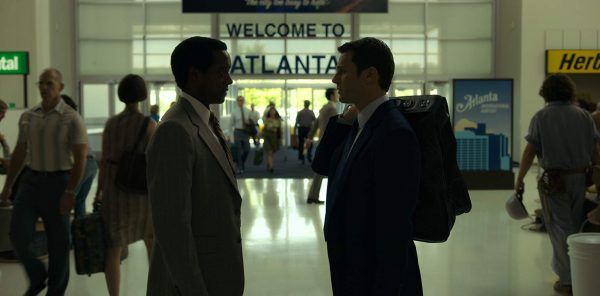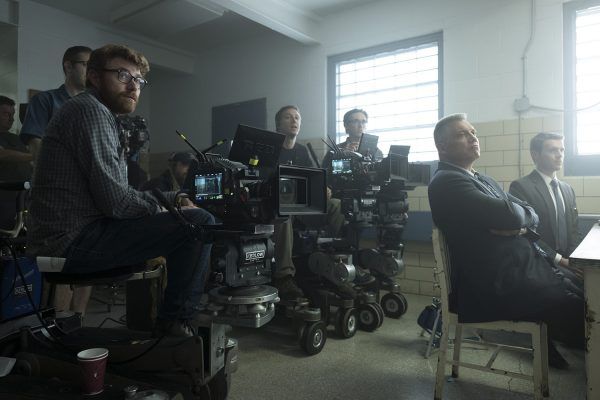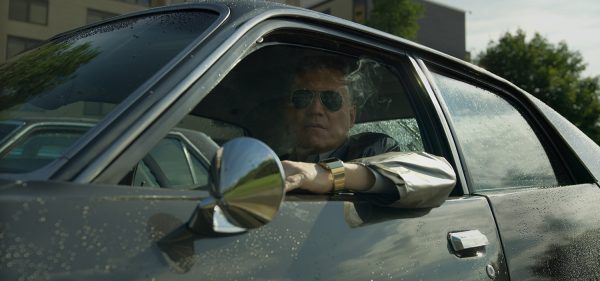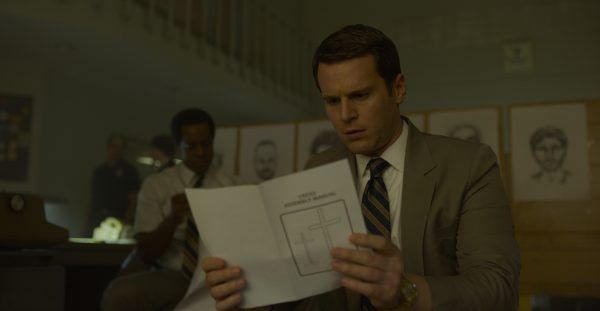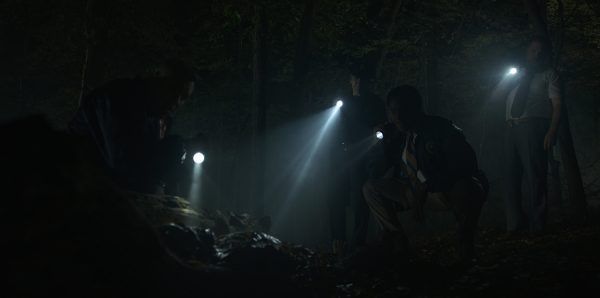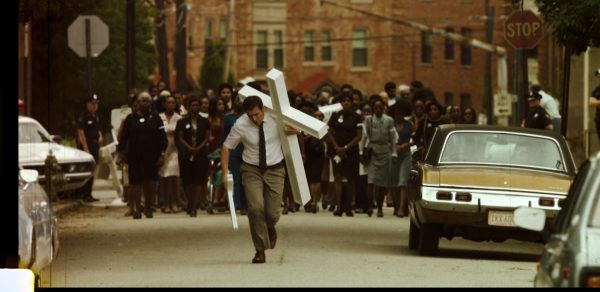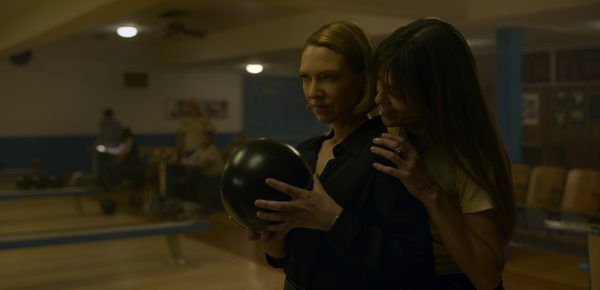The Netflix original drama series Mindhunter is one of the best shows on television. It’s compelling and challenging in the best way, as it traces the early days of the FBI’s Behavioral Science Unit through the eyes of a pair of ambitious yet troubled detectives who spend their time interviewing serial killers, looking for insight that could help them catch future killers. It’s also a wildly cinematic show, which should come as no surprise given that it hails from executive producer and director David Fincher.
Season 1 of the series was focused on the origins of the Behavioral Science Unit and found Jonathan Groff’s Holden Ford, Holt McCallany’s Bill Tench, and Anna Torv’s Wendy Carr working mostly out of Quantinco and conversing in interrogation rooms. The tremendous second season of the series, however, saw Ford and Tench forced to move into the field as the FBI is called in to consult on the “Atlanta Child Murders” and help track down a serial killer in Georgia.
This posed unique challenges and wonderful opportunities for the Mindhunter production team, as cinematographer Erik Messerschmidt told me in an extended interview I conducted by phone back in April. Messerschmidt worked on Season 1 of the series and returned for Season 2, for which he served as director of photography on all nine episodes—a rarity in the television world. During our interview, Messerschmidt talked about why they decided he should be the cinematographer on every episode and offered tremendous insight into how this impeccably crafted show is made. He discussed the intense planning that he and Fincher went through to map out the visual language of Season 2, specifically speaking to how they crafted that incredible interrogation scene set entirely in a car. He also talked about the challenge of shooting a show like Mindhunter on location as the show expanded into the outside world of Atlanta, and what his role as the “visual constant” was like when working with directors Andrew Dominik and Carl Franklin on the season’s latter episodes.
With reports having surfaced that a potential Mindhunter Season 3 is “on hold” for the moment while Fincher focuses on making a film, I also asked Messerschmidt about the likelihood of a third season happening. And since Messerschmidt served as Fincher’s cinematographer on his upcoming Netflix film Mank—which is presented in black-and-white and chronicles the making of Citizen Kane—I asked about his experience working on that highly anticipated feature film.
If you’re at all interested in how the Mindhunter team was able to achieve such a handsome, controlled aesthetic this interview offers invaluable insight into that process, and what a collaboration between Fincher and his DP looks like on a longform series. With any luck this excellent show will be rightly recognized by the Emmys folks come voting time...
Check out the full interview below.
I know you shot season one. When you're coming into season two, was there anything specifically that you guys wanted to do differently or change? Did you have a conversation with David about the visual language of the second season?
ERIK MESSERSCHMIDT: Well, we felt like in the first season they're traveling all over the country, and it’s the expedition aspect of learning what it is these agents do as they learn what they're doing. That was the central focus of the season and we weren't taking a lot of time necessarily to pay attention to what specific parts of the country look like, because we're more interested in the characters themselves and what the situations were that they were getting themselves into. I think when it came time to do the second season, we really wanted to make sure that Atlanta had a feel, that it felt like Atlanta, like it felt sticky and hot, the sun was out and it was humid.
When we jumped back and forth between Quantico and Atlanta you really feel that they're out now in the real world. In the first season and in the beginning of the second season they're interviewing killers that have already been incarcerated and been convicted, so there's an element of security to some extent. They’re environments for Holden, he can run wild and ask the questions he wants to, and even though there's implications to them, they're in a prison or an interview room somewhere, and there isn't as much at stake, necessarily, except his own ego.
Now they're in the real world dealing with a real case and suddenly things matter a little bit more. So the environment seemed more relevant and we wanted to make it somewhat of a character in the story. I mean, it's obviously so important anyway because Atlanta is as crucial to the story itself. The socioeconomic situation, the politics of the city and all of that was so important to the story we were telling.
It's a lot of fun to see them out in the field in Atlanta. I have a number of coworkers who live in Atlanta and they were talking about how accurate it was, down to the sounds of the bugs outside and everything.
MESSERSCHMIDT: (Laughs) Yeah, yeah, exactly. If you've spent any time in Atlanta in the summer, it's hard to forget it.
You shot every episode this season. Mindhunter is, I imagine, not like most other shows, so I was just kind of curious what that production looks like. Are you block shooting? What kind of challenges does it bring breaking it up and stuff?
MESSERSCHMIDT: Yeah, I think we felt like we initially talked very briefly about whether or not it would be worthwhile alternating DPs like a lot of TV shows do and all of us unanimously agreed that it was not something any of us really were interested in doing. Obviously there's a cost associated with that to some extent, but what we did is we block shot. We shot two episodes at a time with each director. Carl Franklin did four so we split his up a bit, but we did two episodes at a time. And then we took a little bit of time off, a week or 10 days or something, I can't remember exactly, in between each block. And that's where I had an opportunity to prep with each incoming director and with David and the writers and tech scout and work with the keys and the art department and we'd look at what was coming up next.
But, the show is relatively contained in that we had all the scripts in advance. We kind of knew where we were going, they had a very good idea how much of each episode took place in each set. So, in the initial series prep, we had a lot of time to discuss where we wanted to put our resources, because we knew exactly what the page counts were in those incoming sets. The production designer and I had a time to sit down and look at the drawings and we talked about where things were going to exist on stage and on location and the key grip and I had an opportunity to talk about our approach so I think that's really important to some of the successes of Mindhunter is the fact that we knew where we were going at the beginning.
In a lot of shows, that's not really the schedule unfortunately. In many cases you get the script a couple of weeks before your prep starts, or in many cases, the first day of your prep. I've certainly been in that situation. So, you're always a little bit behind, and then of course it would be much more difficult to do that as a single DP in that kind of situation. I think it helped too, after the first season, the fact that everyone came back, the operators and myself, and it was the same team behind it. We were in a really good place to support each director and articulate what the style of the show was and anticipate how David might react to certain choices we were making and how to best push the visual language of the show forward.
I know David directed the first three, then you have Andrew Dominik and Carl Franklin. David has a very specific style and way of working. I was wondering how the three directors’ styles differ and what it's like for you being the primary constant visual force on every episode?
MESSERSCHMIDT: Well, I think that's the challenge every DP faces in episodic television. In feature filmmaking, you are entirely at the service of a director and you are supporting their visual language and their choice and their choices, and that is the job. I think episodic television is a little bit more complex, in that you're sort of managing the overall visual tone of the show and not just from a lighting standpoint, but from a camera direction standpoint. Certainly in Mindhunter, I think, there's a very specific style in how we tell those stories. I don't think David or I, we weren't interested in instructing the directors how to tell the story, but we certainly were hopeful that they would look at what we had done in the first season and the first few episodes of the second season and build on it and bring something to the table. Their own approach, their own methods of storytelling, their own interpretation of the themes of each scene and the beats of the scene.
But at the same time recognizing what it was we were trying to do in the totality of the entire nine episode season, and then the show itself. It's challenging because you want to take every idea and support it and run with it. That is the job of a cinematographer, but at the same time, I think in television it's important to make sure that the guest directors that have come in are aware of what it is you've done before and what it is you plan to do in the future. In our case, for sure, there were scenes ins episode six, seven, eight, nine that we knew we were going to do and we already had an approach for how we wanted the scenes to go.
There are set ups, in Andrew’s episode for example, that have to carry through, and the visuals are part of that. So, there's always an open conversation and the directors that come in are supportive of that as well. And they all were, they were fantastic. They were really interested in and respected what we had done and they had ideas. Carl Franklin came in and he had a bunch of things. He wanted to do handheld, and we hadn't really done any handheld on the show before, and we did it, and it works. I think there's a creative collaboration that goes on in every relationship like that. And that's what we were striving to do, and I think we did it. But it’s not easy.
I can imagine. Carl’s episodes in particular were I think just really strong. Obviously partly to do with the script. I mean, everything kind of reaches a boiling point in those final four episodes, and he just knocked it out of the park.
MESSERSCHMIDT: He really did. Yeah, he's fantastic. I think that there's also a thing that happens, and in some shows it becomes a kind of magical potion of everyone is firing on all cylinders and people are excited about what they're doing. That was definitely the case. I've been on TV shows where you sort of get into episode seven of 10 and everyone is looking at the finish line and they're tired. That wasn't really the case on Mindhunter. People were generally really excited to be there every day and interested in what we were doing. People were watching dailies. I mean, that's so cool. Dolly grips watching dailies every day and looking for the mistakes that were made and asking questions and coming with ideas.
That's fantastic when everyone participates. We were really fortunate to have that with the crew and I think that really shows in Carl's episodes. Not to take anything away. I think Carl is really fantastic and special and creative and smart and amazing and brings so much, but he was fortunate to have a bunch of people around him that were really excited by his enthusiasm and were into what it was that we were doing. That makes such a difference.
Something I really was surprised by in season two, delightfully so, is that if season one is kind of primarily focused on Ford, season two really brings Tench to the forefront. It really is kind of his season. These two characters see the world very differently, Ford and Tench do. I was curious how that kind of slight shift in point of view may have been reflected in your approach to the cinematography.
MESSERSCHMIDT: Well, Holt MacCallany is an incredible actor, he's really unbelievably versatile and sensitive and smart. We'd have a blocking rehearsal and every rehearsal he'd come in and it's like, "Hold on, I got a question." Holt does his homework. It's always great to work with actors like that. He and I, over the course of the two seasons, became really close friends. I think the Holden story that we see in the first season and the narcissism of that is part of the show and it's kind of the backbone of the show. We definitely see that at the end of the second season, where he is starting to question all of his choices, the existential crisis that he goes through and Holt's conflict between being a good father and a good husband and doing the work is really, like you say, it's a huge part of the story we tell in the second season.
I think we were interested in the interpersonal relationship between Holt and his wife, and of course the complications of the special needs child that they have and how he deals with that. One of my favorite scenes in the show is where Holt is on a retreat with the other senior executives at the FBI and they're talking about math and he's talking about camper and describing what's going on, and the director of the FBI indirectly suggests that anyone who's recognized to be crazy should immediately be incarcerated. I think Holt listens to the story, and in that scene we see him really start to look inside and think about his own situation and it really touches him. I think it was a little bit unexpected to some extent that we could take the show there because it really wasn't something that we had done. The show isn't sentimental all, that's not really what it is, but it is deeply personal and I think that excited the writers and the actors to take it there. I think we're blessed to have an actor like that, that could play a character with that much depth, and with that much subtlety. The performances are so subtle and nuanced by design and it's pretty complicated to pull that off, I think. We had somebody who could do it so they were willing to try.
We didn't take any really different visual approaches. There's a scene where he comes home and his wife has sort of had it and she's frustrated. Carl directed that scene, it's really beautiful. She just kind of... it's a dance floor move. We push around her face and she tells the story about her son and it's a really, really well executed shot. And Brian Ottoman, the operator and Dwayne Bar, the dolly grip are probably the best in the business, as far as I'm concerned. If you watch the scene it's really spectacular in terms of how subtly it moves.
It's great. I just think that whole Tench storyline just adds to the show. As you say, it's not a sentimental show, but it is a deeply human show. I think that idea of seeing these killers as human beings and wondering how could a human do this kind of thing, I think that just adds even more complications and more of an emotional aspect to the Tench stuff.
MESSERSCHMIDT: Yeah, for sure. Absolutely. I think that's the big conflict of the show is are these guys human and how do we show that and how do we explore that? Now the contrast between the people who are obviously human and then watching someone like Holden evaluate his own humanity and start to question his own choices. In the beginning he sees himself as this kind of altruistic FBI agent and a sort of All-American kid, and then you see him slowly evolve into slightly more of a monster.
Yeah, for sure. I did want to talk about one scene in particular that really struck me. I think everyone was kind of talking about, which is in episode two, in which Tench is interviewing a survivor of BTK in car. It's haunting and terrifying and it's just three guys talking in a car. I was wondering if you could talk about the construction of that scene with David and the decision-making that went into that, because it's incredible.
MESSERSCHMIDT: Oh, thank you. Yeah. We got the scripts for that scene, I think it was early, it was probably three months before we started the production. That was the first scene I emailed David about. I said, "Hey, how are we going to do this?" Because it was really important, and it wasn't scripted that this was a “don meetup.” I don't know what it is, it's probably eight or nine minutes long in the show. I think it was an 11-page scene. I can't remember, but it was long.
If you watch the scene and how we wanted to do it, we were going to break this up into a lot of pieces of coverage and we really wanted to be able to move the audience around the car. There's only so many places you can put the camera in the car without looking like you're trying to be more creative than you need to be I think. We talked a lot about where were we going to put the camera and how were we going to break it up? When we got in production we discussed different ways to accomplish this. The way we decided was that we would shoot plates and we would shoot the scene on our—we had a car process which we had initially developed in the first season, then expanded upon in the second season. It was a quite elaborate set up that uses LED video wall as interactive light and a green screen background. We took our plates in and we went to the location where the exterior portion of scene was shot. We shot 15 minutes of plates over the course of the dawn period. So we had the rising sun light. That then went on the stage and then I think it took us two or three days to shoot the scene. We were really methodical and we broke it down. I don't know how many pieces of coverage there are, but there's quite a bit. It's 12 or 15 setups or something.
We moved the camera around and initially we had discussed whether or not we wanted to show Kevin's face. We had explored that idea in the prep, but we were sort of like, well, I think it might be interesting if we never showed his face. The big part of his character is that he doesn't want Tench to see him. He's always hiding in plain sight. So we ran with that idea and we decided ultimately, and editorially they went that way, that you see him sort of out of focus behind Tench and you see him through the reflection of the window. Dave and I talked a lot about how can we cut to him? A different way we could cut to him without the audience seeing his eyes.
We came up with some ideas of how we can do that. I think there's a profile shot in the cut where you just see his hair and you maybe see a glimpse of his nose. Then we had the reflection shots at the window and then Holt turns around so all the questions are done facing forward, so we put the camera on the front hood and shot Holt very shallow depth of field so that Kevin is just out of focus in the background.
We played the content back from the video walls so that we could get the sun rising dawn light on their faces over the course of the scene. So, yeah, that's fun. I'm proud of that scene. I think it works really well for the fact that nobody's moving around and no one looks at each other. That's one of the big things in the show, it's like, most of the show is people sitting across the table from each other, looking at each other. I think in cinema, we rely a tremendous amount on the interaction of eyelines with people looking into each other, and actors rely on it as well, actors rely on being able to look at the other actor and react to their eyes.
We played a lot with that cinematically in the show with how close to the lens do we have an actor look and how close do we have the off camera actor sitting next to the camera when we're shooting a clean single. How do we use the eyeline dramatically for the audience's benefit? In that scene that goes out the window, we couldn't use that. We had to come up with different ways to do it.
That's crazy. I was going to ask you about the car scenes because the car scenes look incredible and I know you had used LED walls. I had no idea that that was not shot in a parking garage, that scene. That's really fantastic.
MESSERSCHMIDT: Oh really? That's cool. Yeah, yeah. We've done so much of that, David and I, over the years and every time we do it, we work on it more and more. We self assist to shoot plates, and we try to... A huge part of that is the fact that we pre-visualize all of our camera angles in advance of the plates match. It makes it much easier for the post people to drop them in. Unfortunately, I think when you shoot on an insert car, when you shoot partially on an insert car, first of all, it's dangerous, even in the safest possible situation, but also most of the conversation has nothing to do with the performance.
It's all about locking up the street and figuring out a way for the director to communicate with the actors inside the car. Sometimes the actors have to plate themselves and the sun is moving. There's all sorts of other technical factors that are part of the filmmaking process that are antithetical to the director-actor relationship. It makes it very difficult I think, to shoot compelling car scenes. Certainly if you want more than a couple of good takes. We have, over the years, elected to do it this way. I think it has proven to be really effective, for us anyway.
And kind of to that point, there were a lot of exteriors this season, especially nighttime exteriors, and you've got flashlights and cop lights and it all looks fantastic. It's incredibly evocative. I also know that David's films are not necessarily super bright. So what was that like tackling those particular scenes?
MESSERSCHMIDT: Yeah, most of the more "elaborate" night exteriors I think are in the later episodes. Carl has some pretty big ones with the Wayne Williams stuff on the bridge, and there's some stuff in the woods when they find the bodies. I think the show is, thematically it's dark, but it wasn't something where I felt like it was appropriate. It's en vogue now to go really dark. “How dark will the studio let me go?” There's a whole thing. That doesn't really excite me so much anymore. There was a time in my life where I was like, “Let's go for it!" I think that we try to take the context of the scene into account. And where it was appropriate for it to be dark, we were dark, and where it wasn't, we weren't.
I think the show gets some credit in their cases for having a stylized look, but to be honest, most of the time, we're really trying to just think about how these places would have looked and how they would have been lit. When they're in the woods, how do these guys triage these searches? What are they using? If they're using flashlights, they should have flashlights. It was really try to just break it down into the elements of what would be there, how would it work aesthetically in our favor, but really fundamentally, from it from a place of realism I should say.
There's a bit of kind of heightened realism of the show, or aestheticize, I don't know if that's a word, but we've definitely taken a point of view, but I wasn't trying to make it darker or moodier than it necessarily needed to be. I mean, it's always tempting, but I think there's a point where you really have to think about what is the context of the scene and making sure that you don't take away from the scene because of a choice you think might be a visually interesting.
Was there a particular scene or sequence this season that was especially challenging that took you guys a while to kind of crack?
MESSERSCHMIDT: Well, I think the one we just discussed in the car was complex because it had lots of layered elements. There's the march sequence in Carl's episode, I think it's six or seven, which-
Oh yeah. That sequence is great.
MESSERSCHMIDT: That took a couple of days to shoot and had a lot of extras. We were trying to play with this idea of found footage. A lot of what we do in the show is what lots of cinematographers do, but fortunately producers that support this, is we schedule around the weather as much as possible. A lot of the scenes are often much longer than what most people deal with in the television sphere.
So, that makes exterior shooting substantially more complex because a six page scene outside is way more challenging to keep consistent than a two page scene. Just by nature of the duration it takes to shoot it and the likelihood that the weather's going to change, particularly in Western Pennsylvania. I think for us, the exteriors in particular were challenging, especially because it's not something we did a lot of on the show historically.
Then the night exteriors in particular, where there's some bigger ones that were complex in approaches, there's a really elaborate oner dolly shot in Carl’s episode, I think it's in eight or seven, where they're walking, it's like another dusk scene. They're going to suspend the search and there's a long walk and talk between the chief of police and Holden and it sort of evolves. Eventually the press gets wind of it and I run into the car and that's where we first see Wayne Williams and just get a glimpse of Wayne Williams. That was complex because we knew that we had to shoot it. The whole reason they're suspending the search is because the light is waning and it's getting more and more difficult for the helicopters to fly, and so it had to happen at the dusk, but it's a three or four page scene discussion. So what Carl ended up deciding to do was, we laid, I think, 400 feet of dolly track, and we shot it with a single camera, and we rehearsed it heavily in the days prior. Initially Carl and the assistant directors, we laid tape down on the stage floor and the actors ran the scene a couple of times, we worked out the beats and then the assistant directors took tape and they went out on location and they orchestrated the background relevant to those marks.
Then we went in at noon or something, and we rehearsed it for four hours and got all the beats down with the cast and the background and the search dogs and the dolly grip and the operator until the shot was perfect. I think the shot that made the cut was the third or fourth take or something. Right when the light was kind of perfect. That took a lot of planning and a lot of time. It's hard because people watch it and I don't know that they even notice, which is the intention, but definitely a lot of work went into it.
That's crazy.
MESSERSCHMIDT: The show in general, the visual approach has always been, and we've always said, it is not meant to be flashy. If someone notices my work, it's really problematic because it's not the intention of the show at all. We've always approached it from what is the simplest, cleanest, most elegant way to do something without drawing attention to whatever it is we're doing.
Yeah. But I think it's evocative though. You can tell when the cinematography is purposeful and not, and with this show, I think what really sets it a cut above is every shot is purposeful.
MESSERSCHMIDT: Thank you. Yeah. That's the idea. It was never like, “I'll take the B camera and just get something extra.” You hear that a lot, especially in television. We did shoot almost the whole show with two cameras, but we blocked for two cameras with the intention of using two cameras and with the intention of each shot meaning something and bringing something to the cut for the editor to work with. It was never like, "That's a freebie. Let's just get a profile here and maybe it'll make the cut." That's not how we approached it at all.
As I said, I'm a massive fan of the show. I think it's one of the best shows on TV. I know David has said there's kind of a five-season plan, but reports came out recently that things are on hold. Do you know the likelihood of season three happening?
MESSERSCHMIDT: I don't. I don't. We just finished this movie [Mank] and I've heard things are on hold for a little bit. We'll see. Who knows? But it would be an honor to go back. I love working with David and adore the cast and the crew, and it's been an incredible period of my life for certain. I've been really blessed to have the opportunity to work on it and contribute to it. It's been particularly important and poignant in my career. But yeah, I don't know. I don't know what's going on.
Don’t get me wrong, I'm incredibly excited for a new David Fincher film, but I want to see this story conclude at some point.
MESSERSCHMIDT: Yeah, yeah. For sure.
To that end, I have to ask you about Mank. It's my most anticipated film of the year. I know you probably can't say much, but what was it like shooting a historical drama about the making of the greatest film ever made?
MESSERSCHMIDT: (Laughs) Yeah. Again, it's an absolute blessing, incredible opportunity. I think Citizen Kane, for all of us in the cinematography community, is a significant film and certainly something that we all aspire to. It's intimidating to make that movie, but also a tremendous joy. Black and white is just a fantastic medium to work in. As a cinematographer it's amazing. You break the elements of the process down into the light and shadow and shape and texture. You don't have the luxuries of color separation, all those tools that we have in color photography, just to develop a shot. Working in black and white is the opportunity to perfect the perfect French omelet. It's just a couple ingredients is all you kind of get. It was just an amazing experience. I look forward to seeing the finished film and showing it to people and hopefully people respond to it. It's a really great story and any opportunity to work with David is... When my phone rings and he calls, it fills me with joy.
I can imagine.
MESSERSCHMIDT: I was honored to participate.
It sounds like it's unlike anything he's ever done before.
MESSERSCHMIDT: Yeah, I think so. I think it's absolutely a different film for him and that's a really great thing for filmmakers to undertake I think. As creative people, I think we all want to challenge ourselves and take on ideas and approaches to things we haven't done before. And this is an important film to him. For a long time he's been trying make this movie and I think it was great to be next to him for that process. It’s definitely different, but it of course has his handwriting all over it obviously. It was an amazing process to participate in.
The first two seasons of Mindhunter are now streaming on Netflix, and Mank will be released by Netflix later this year.

